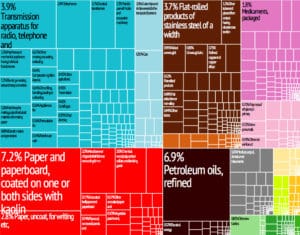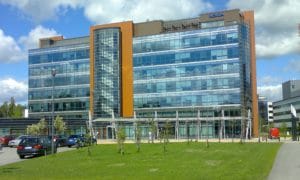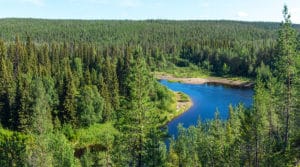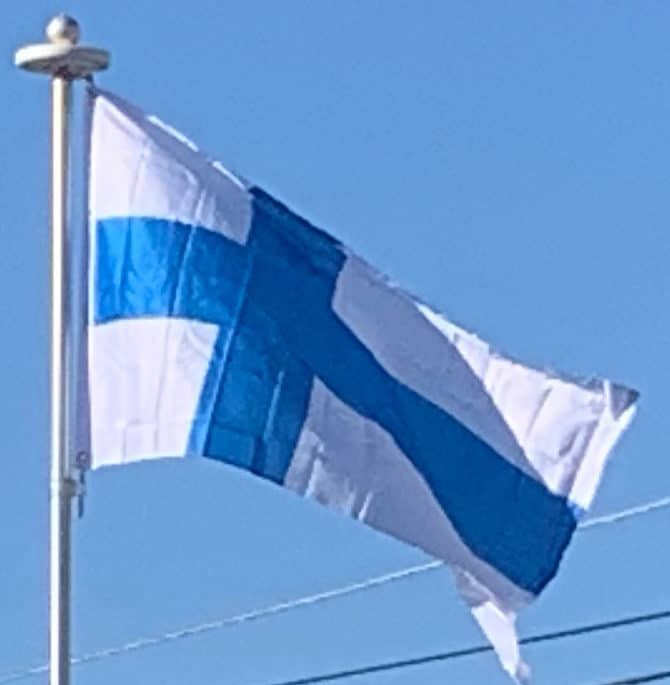The landscape is covered mostly by coniferous taiga forests and fens, with little cultivated land. Of the total area 10% is lakes, rivers and ponds, and 78% forest. The forest consists of pine, spruce, birch, and other species. Finland is the largest producer of wood in Europe and among the largest in the world. The most common type of rock is granite. It is a ubiquitous part of the scenery, visible wherever there is no soil cover. Moraine or till is the most common type of soil, covered by a thin layer of humus of biological origin. Podzol profile development is seen in most forest soils except where drainage is poor. Gleysols and peat bogs occupy poorly drained areas.
Economy:
The economy of Finland has a per capita output equal to that of other European economies such as those of France, Germany, Belgium, or the UK. The largest sector of the economy is the service sector at 66% of GDP, followed by manufacturing and refining at 31%. Primary production represents 2.9%. With respect to foreign trade, the key economic sector is manufacturing. The largest industries in 2007 were electronics (22%); machinery, vehicles, and other engineered metal products (21.1%); forest industry (13%); and chemicals (11%). The gross domestic product peaked in 2008. As of 2015, the country’s economy is at the 2006 level.

Finland has significant timber, mineral (iron, chromium, copper, nickel, and gold), and freshwater resources. Forestry, paper factories, and the agricultural sector (on which taxpayers spend around 3 billion euros annually) are important for rural residents so any policy changes affecting these sectors are politically sensitive for politicians dependent on rural votes. The Greater Helsinki area generates around one third of Finland’s GDP. In a 2004 OECD comparison, high-technology manufacturing in Finland ranked second largest after Ireland. Knowledge-intensive services have also resulted in the smallest and slow-growth sectors – especially agriculture and low-technology manufacturing – being ranked the second largest after Ireland. The overall short-term outlook was good and GDP growth has been above that of many EU peers.

Finland is highly integrated into the global economy, and international trade produces one third of GDP. Trade with the European Union makes up 60% of Finland’s total trade. The largest trade flows are with Germany, Russia, Sweden, the United Kingdom, the United States, the Netherlands, and China. Trade policy is managed by the European Union, where Finland has traditionally been among the free trade supporters, except for agricultural policy. Finland is the only Nordic country to have joined the Eurozone.

Forests play a key role in the country’s economy, making it one of the world’s leading wood producers and providing raw materials at competitive prices for the crucial wood-processing industries. As in agriculture, the government has long played a leading role in forestry, regulating tree cutting, sponsoring technical improvements, and establishing long-term plans to ensure that the country’s forests continue to supply the wood-processing industries. To maintain the country’s comparative advantage in forest products, Finnish authorities moved to raise lumber output toward the country’s ecological limits. In 1984, the government published the Forest 2000 plan, drawn up by the Ministry of Agriculture and Forestry. The plan aimed at increasing forest harvests by about 3% per year, while conserving forestland for recreation and other uses.
Transportation:
The extensive road system is utilized by most internal cargo and passenger traffic. The annual state operated road network expenditure of around 1 billion euro is paid with vehicle and fuel taxes which amount to around 1.5 billion euro and 1 billion euro.
